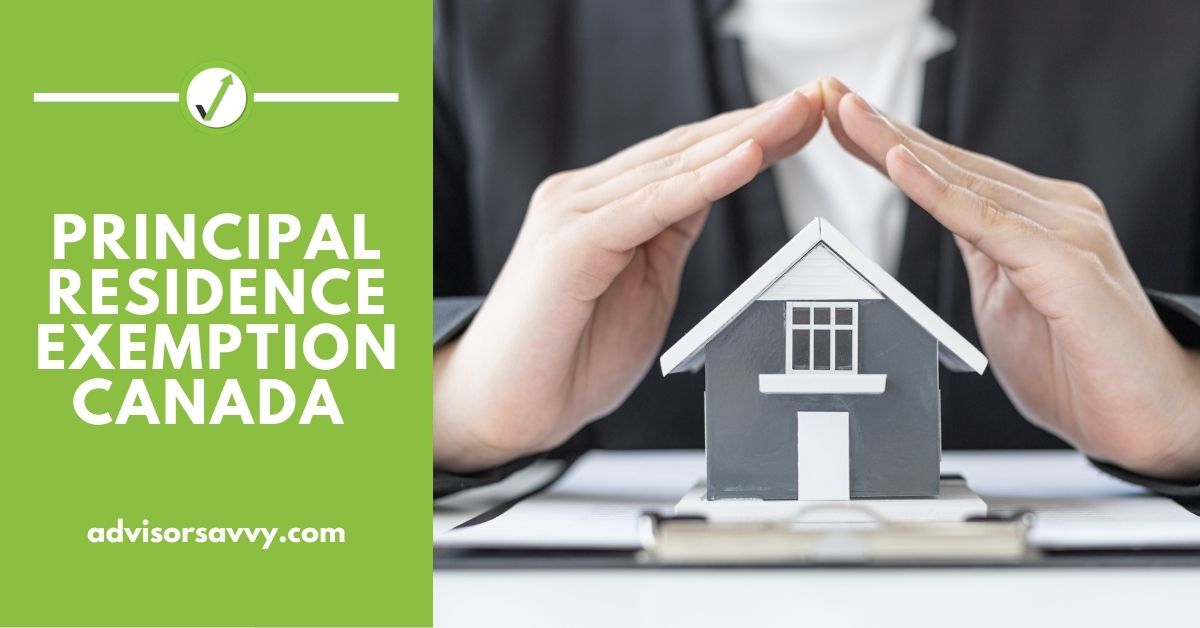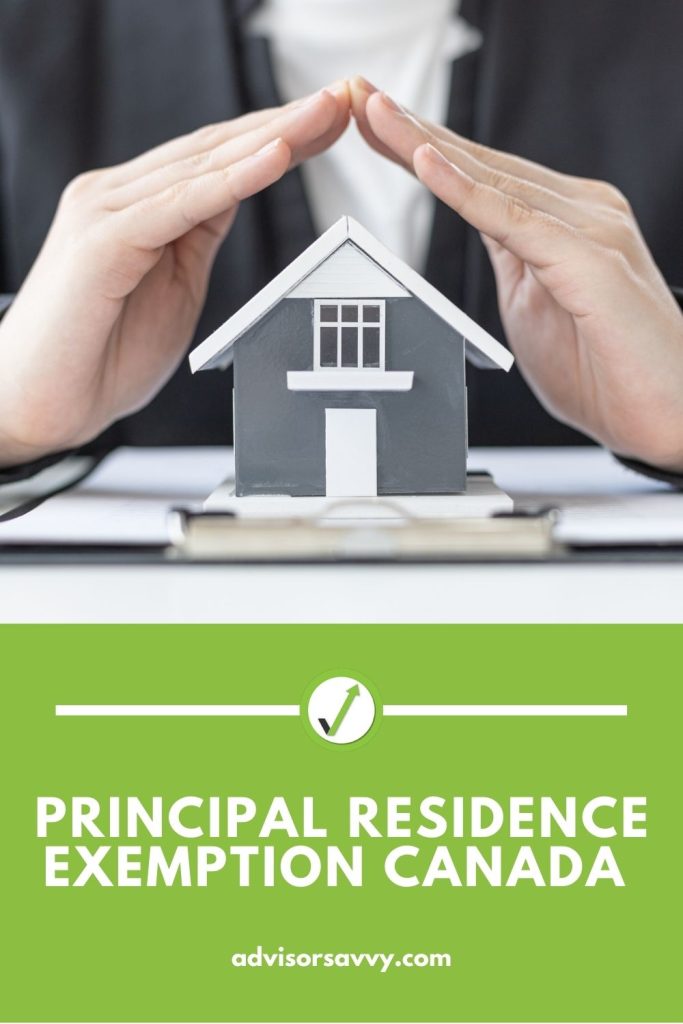
Are you a homeowner who’s thinking of selling your property soon? If so, you may be eligible for the principal residence exemption in Canada which can save you a significant amount of money on your taxes. In this blog post, we will explain what the principal residence exemption is and how you can claim it. We will also provide some examples to help illustrate how the exemption works. Homeowners and home sellers, keep reading to learn more!

Table of contents
What is the principal residence exemption?
The principal residence exemption in Canada is a special provision in the Income Tax Act. In some ways, it behaves like a tax credit. It allows Canadian residents to exclude any capital gain realized on the sale of their primary residence from taxable income. The exemption applies to Canadian residents only. It can be claimed on only one property at a time, better known as your principal residence.
The idea behind the principal residence exemption is to not discourage Canadians from selling their properties. Naturally, the capital gain on a property can be quite significant. For this reason, Canadians may be deterred from selling their homes to avoid the tax burden. This could lead to people hoarding property instead of turning it over. Cyclical activity of buying a house, then selling, is part of a healthy economy. The principal residence exemption in Canada eliminates a substantial portion of the tax so homeowners are not deterred from selling their homes.
Related Reading: Capital Gains Tax in Canada
Principal residence exemption guidelines
There are a few conditions that must be met in order to qualify for the exemption, so it’s important to understand how it works before you sell your home. Let’s explore in detail below.
Quality and type
A cottage, an apartment in a building, a trailer, or a house may all be considered a primary residence. There is no minimum threshold of value, quality or type of property that is eligible for the principal residence exemption in Canada.
The ordinarily inhabited rule
A principal residence must be “ordinarily inhabited,” according to the Income Tax Act. This means it must be inhabited, at least in part, during the year by the taxpayer or the taxpayer’s spouse, common-law partner or cohabitant, or child. If the taxpayer in question has multiple properties, normally the principal residence would be the property where the taxpayer (or other eligible parties) spends the most time during a given calendar year. For instance, let’s say a taxpayer has a condo in Toronto and a cottage in Muskoka. The taxpayer spends most of their time in the Toronto condo and occasional weekends at the cottage. The principal residence in this example would be the Toronto condo.
Classification
The principal residence exemption can be claimed on your annual tax returns for the year in which your home is sold, but you can only declare one property as your primary residence. You need to consider your entire family when determining eligibility for the exemption. This includes yourself, spouse or common-law partner, and any unmarried children under 18 years old. For example, if your partner sold their first property before you did, they may have already used up the allotted portion for claiming the exemption. In other words, the exemption is not unlimited. Plus, the more property your family owns, the less lucrative the exemption becomes.
Ownership
You must be the owner (or co-owner) of the property for which you’re seeking a capital gain exemption. If you are renting or leasing a property, you cannot claim the principal residence exemption in Canada.
Usage
The property in question must be used for primarily personal use. If the sale of the property resulted in business income, then you cannot claim the principal residence exemption against the income, unfortunately. In addition, properties owned for the purpose of generating rental income or other business income are usually exempt from the principal residence exemption in Canada.
Related Reading: Tax Implications for Canadian Snowbirds
Who qualifies for principal residence exemption in Canada?
The principal residence exemption is a valuable tax break that allows Canadians to avoid paying capital gains taxes on the sale of their home. To qualify for the exemption, the home must be your principal residence and you must be a resident of Canada. Your principal residence can be a house, condo, cottage, trailer, houseboat or any other similar kind of dwelling. In addition, you don’t have to own it outright; you can still claim the principal residence exemption if you have a mortgage. If you meet all these requirements, you can sell your home without having to pay any capital gains taxes on the sale via the principal residence exemption in Canada.
Related Reading: Tax Loss Harvesting Canada
What if I have two properties?
The Canada Revenue Agency (CRA) allows homeowners to claim an exemption on the sale of their principal residence. This exemption is available to all homeowners, regardless of how many properties they own. If the homeowner has owned more than one property during that time, they can choose which one to designate as their principal residence. Keep in mind there are rules surrounding the definition of a principal residence — you cannot just dictate what it is. Generally speaking, it’s the property you spend the most time at during a calendar year.
If you have two properties, one of which is your principal residence, you can only claim the principal residence exemption for the years which the property in question was your principal residence. In other words, you can use the principal residence exemption on multiple properties, but you can only claim it for the years which the property was your principal residence. However, if you sell your principal residence and then buy another property within a year, you can still claim the full exemption on the sale of your home. This is because there would be no overlap in homeownership.
Related Reading: What You Need To Know About Buying A Cottage In Canada
Principal residence exemption calculation example
Since the application of the principal residence exemption changes when multiple properties are involved, let’s take a look at two examples: one with only one property and one with multiple properties.
Principal residence exemption calculation – one property
Maria has owned her home for 15 years and doesn’t own any other property. It has been her principal residence for 12 years and she was a Canadian resident when she originally bought the property. The property is worth $1 million currently, and she bought it for $250,000 originally. Maria is still a resident of Canada and sold her house in 2022. Her principal residence exemption is calculated as follows:
| Capital gain ($1,000,000 – $250,000) | $750,000 |
| Years as principal residence plus one (12 + 1) | 13 |
| Total years of ownership | 15 |
| Principal residence exemption [(13/15) x $750,000] | $650,000 |
| Capital gain after principal residence exemption ($750,000 – $650,000) | $100,000 |
Maria only needs to claim $100,000 of capital gains on the sale of her home in 2022 after the principal residence exemption.
Principal residence exemption calculation – multiple properties
Mark purchased his first home 15 years ago for $300,000. Five years later, Mark purchased his second home, a summer vacation property, for $200,000. Over the last 13 years, the first home was Mark’s principal residence. But during the pandemic, Mark was working remotely from his summer vacation property and no longer needed his first home. He sold his first property for $500,000 and lived permanently out of the summer vacation property. At this point in time, the summer vacation property became Mark’s principal residence. In the current year, Mark decided to sell his summer vacation property for $600,000 to become a digital nomad. Mark has been a resident of Canada for the last 15 years inclusively. His principal residence exemption calculations are as follows:
| FIRST HOME | |
| Capital gain ($500,000 – $300,000) | $200,000 |
| Years as principal residence plus one (13 + 1) | 14 |
| Total years of ownership | 15 |
| Principal residence exemption [(14/15) x $200,000] | $186,667 |
| Capital gain after principal residence exemption ($200,000 – $186,667) | $13,333 |
| SUMMER VACATION PROPERTY | |
| Capital gain ($600,000 – $200,000) | $400,000 |
| Years as principal residence plus one (2 + 1) | 3 |
| Total years of ownership | 10 |
| Principal residence exemption [(3/10) x $400,000] | $120,000 |
| Capital gain after principal residence exemption ($400,000 – $120,000) | $280,000 |
On Mark’s first property, he would only claim $13,333 in capital gains. On Mark’s second property, he would have to claim $280,000 in capital gains.
Related Reading: Marginal Tax vs Average Tax: Understanding Canadian Tax Brackets
How to claim principal residence exemption
To claim the principal residence exemption on your tax return, you will need to fill out Form T2091. This form is used to declare the property you designate as your principal residence for the year. You can find this form on the Canada Revenue Agency’s website.
There are a few things you will need to know before you can fill out the form. First, you must declare the property as your principal residence for at least one day during the year. Second, the property must be located in Canada. Third, you must own the property or be a co-owner with at least half of the interest in the property. And finally, you must live in the property or intend to live in it at some point in the future.
If all of these conditions are met, you can fill out Form T2091 and declare your principal residence. You will need to provide information about the property, such as its address and fair market value on January 1st of the year. You will also need to provide information about yourself, such as your name, social insurance number, and date of birth. Once you have filled out the form, you will need to submit it with your tax return.
On your tax return, you will also need to disclose the capital gain and principal residence exemption calculations. The CRA may ask for supporting documentation for the purchase and sale price during tax season, so be sure to keep this information handy. In addition, it’s a good habit to track years which property was your principal residence, if you have multiple, in the event of a CRA audit.
Read More: What is The Home Buyers’ Plan?

